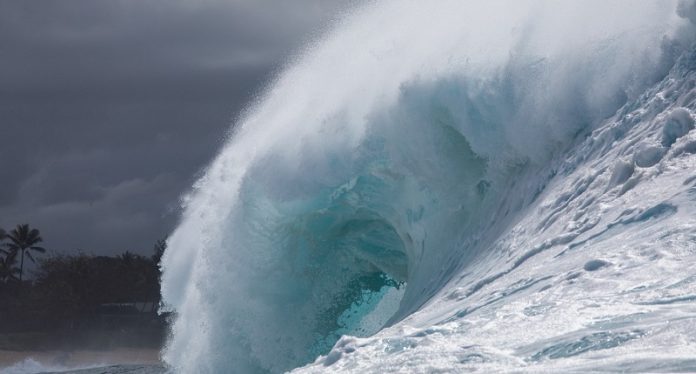
Ocean waves up to 30 meters that seemingly appear at random have long inspired legend and stumped scientists.
Now, researchers at the University of Sydney and Kyoto University are unravelling their mysteries.
Scientists found that extreme or ‘rogue’ ocean waves – colossal walls of water that seemingly appear at random and have the potential to destroy marine infrastructure, carve out coastlines and even threaten life – could be more frequent in multi-directional wave formations than previously expected.
These enormous “rogue” swells have long captured the imagination.
Although mathematical modelling has helped scientists and engineers hypothesise different causes, since the 1980’s it was thought they were caused by either wave overlap (the superposition principle) or a mechanism which triggers a rogue wave (modulation instability) in one-directional wave systems.
In multi-directional systems, known as crossing wave formations or crossing seas, modulation instability was believed to be inactive, rendering extreme waves rare or impossible in these conditions.
The study was published in Physical Review Letters.
Catching a rogue wave
To recreate the sea’s complex conditions, researchers conducted experimental demonstrations in a 30-metre-long wave tank located in the University’s School of Civil Engineering.
A mechanical wave generator was employed to create multi-directional waves on the water’s surface, ultimately resulting in unstable rogue “breathers” – waves that suddenly grow and disappear without any disturbance to the surrounding water.
“What our physical demonstration has shown us is that multi-directional systems can also rise to extreme waves from modulation instability in the form of breathers even when another wave system is at play,” said Adjunct Professor of Civil Engineering Amin Chabchoub.
“Until now, this had not been demonstrated,” said lead researcher and PhD student Yuchen He, who is due to complete his PhD at the end of the year.
“The scientific wave community believed that these rogue waves could only be generated in one-directional wave systems – instead thinking that multi-directional wave formations might cancel out these crucial mechanisms.”
The experimental demonstration showed that crossing water waves, which frontally collide with a crossing angle of 180° and cause ‘standing waves’, also allow breather waves to rise.
Caused most commonly during storms, the researchers caution that extreme waves may pose an increasing risk in the wake of climate change.
“If you’re in a boat and get hit by a 25 to 30-metre wave, it’ll most likely be ‘game over’. Unfortunately, because of climate change, in the future we will see an increase in storm intensities, with more frequent cases of extreme waves,” said Professor Chabchoub.
Mr He said: “Ultimately, the more we unlock the mystery that surrounds how rogue waves appear from flat, calm, or complex seas, we’re creating a better understanding of when and where these giants of the sea are likely to appear.
Such findings are also crucial in developing a reliable forecast tool in offshore, but also coastal areas. Ultimately, this will benefit maritime navigation, and on and offshore coastal operations.”
Source: University of Sydney.



